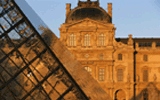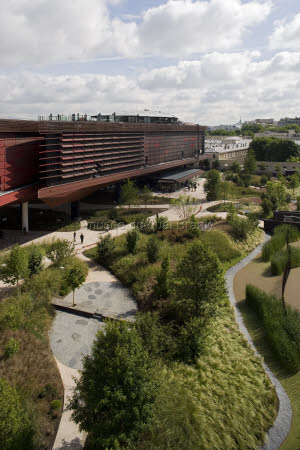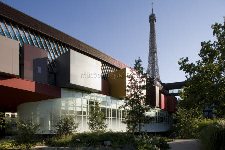Renowed museums

© Paris Tourist
Office -
Photographe : David Lefranc
Below are the top five most visited museums:
LE LOUVRE

Source: www.parisbalades.com
(métro Palais-Royal-Musée
du Louvre)
(tel. answering machine: 01 40 20 51 51, tel. reception 01 40
20 53 17, tickets: 0 803 808 803, open 9.00 -18.00 except Tuesdays,
partially late opening Mondays and fully late opening Wednesdays
until 21.45. To avoid queues, you may enter by staircase on the
left – seen from the pyramid – of the small Arc de
Triomphe in the Jardin des Tuileries, or arrive by metro)
Medieval
fortress, residence of the kings of France, royal art gallery
and then great museum, the Louvre has been cared for and enriched
by each epoch and each political regime. The 5th Republic is no
exception, as it has been concentrating efforts to upkeep and
improve the Louvre for fifteen years. In 1190, Philippe August
constructed a fortress to reinforce his city walls on the bank
of the Seine. Recent works have uncovered the moat and the dungeons,
in which can be seen the medieval Louvre. From 1515, François
I began transform the old stronghold into a renaissance palace.
Henri IV took on the grand project in 1594 of joining the Louvre
to the Château des Tuileries, via two long galleries that
would be dedicated to the king’s art collection.
In the 17th century, the Louvre saw the evolution of the king’s
taste towards French classicism. For the great classic colonnade
of the entrance, Louis XIV preferred the colossal and regular
project of Claude Perrault to the baroque design of Bernin. Giving
on to the place de Louvre, the colonnade has recently been cleared
of scaffolding after several years of renovation. Just behind,
the square courtyard that now leads into the city is delicately
lit up in the evenings (open 07.30 – 24.00 in summer, 8.45
– 22.00 in winter).
Since it became a museum in 1793, the Louvre underwent its last
major transformation under the 2nd Empire, when two galleries
situated around the Cour Napoleon were completed. Almost as soon
as the project to join the Louvre to the Château des Tuileries
was completed, the Château des Tuileries was burned down
by the Commune in 1871.
Since then, the Louvre has been undergoing constant minor adjustments
to become what is now the largest museum in the world.
PYRAMIDE DU LOUVRE

© Paris Tourist
Office
Photographe :
David Lefranc
(architect Ieoh Ming Pei, 1989) Pyramide-Cour
Napoléon 75001 Paris In 1981, improving the Louvre was one of the
great works decided on by President Mitterand. It was decided
to enlarge the museum by taking over the Richelieu wing (on Rue
de Rivoli), which until then had been occupied by the Ministry
of Finance. The ministry moved out to Bercy and the museum went
from having a surface of 30,000 m² to having 55,000 m².
In charge of the project, Leoh Ming Pei proposed building a central
entrance in the Cour Napoléon.
The Louvre project also foresaw the renovation of the Museum of
Decorative Arts area, improvements to the Jardins des Tuileries
and the cleaning of façades. Vast underground merchant
galleries in the Carrousel du Louvre by Michel Macary; the restaurants
of the entire world assembled in a huge buffet, art boutiques,
luxury and leisure stores now receive a permanent crowd.
CENTRE GEORGES POMPIDOU -
BEAUBOURG CONTEMPORAIN

Source: www.parisbalades.com
19 rue Beaubourg 75004 Paris
(métro Rambuteau)
19 rue Beaubourg 75004 Paris (métro Rambuteau) (tel. 01
44 78 12 33, opent 11.00-22.00 except Monday for the centre, 11.00-21.00
for the exhibitions, 11.00-23.00 Thursdays))
(Renzo Piano et Richard Rogers, 1977)

Source: www.parisbalades.com
The major constraint was to get rid of all obstacles
on the interior of the building so in order to have complete freedom
to remodel displays on the interior.
The architects used the constraint by “bringing outside
and displaying the guts of the building”: the metal structures,
the coloured circulation pipes for water, heating, ventilation,
electricity and above all the great escalator in its glass tube.
Completed in 1977, the Pompidou Centre has integrated well with
its old Parisian surroundings, by respecting the original alignment
of the street but also contrasting with the colours and shapes
around it. It’s certainly a modern building (its beauty
is in its content and the freedom of its displays, not in its
decoration) and is very different to the concrete building of
earlier decades. Singular, in any case.
Attracting 25,000 visitors each day, far more than had been predicted,
the centre has just been refurbished and reorganised: the art
museum has almost doubled in size since administration was moved
to the other side of Rue Rambuteau. The public information library
(Bibliothèque
publique d'information) now occupies three levels and has
a separate entrance.
Quai Branly Museum

Crédits photos : © musée du quai Branly, photo Nicolas Borel
37 Quai Branly –Debilly entrance – 75007 Paris
Getting here:
Bus: n° 42, 63, 80 and 92 – ‘Bosquet-Rapp’ stop, and n° 72 – ‘Alma Marceau’ stop
Subway: Line 6 (station: Bir-Hakeim) and line 9 (station: Musée d’Art Moderne – Palais de Tokyo)
RER: line C – station: Pont de l’Alma
Opening times:
Tuesday, Wednesday and Sunday: between 11:00 and 19:00.
Thursday, Friday and Saturday: between 11:00 and 21:00
Closed on Monday and on 25/12 and 01/05 (open on Mondays during school holidays)
On the banks of the River Seine just metres from the Eiffel Tower, you will find 3500 works of art on display at the Quai Branly Museum. There is a collection area made up of artworks from Africa (Madagascar, Sub-Saharan Africa and North Africa), America (pre-Columbian period, colonial and modern), Asia (Siberia, Nepal, China, India and South East Asia) and Oceania (Melanesia, Polynesia and Dutch East Indies) located geographically around the sensory “river”.
The museum’s architecture, by Jean Nouvel (winner of the 2008 Pritzker Prize), is original and impressive, its wild garden, created by the landscape architect Gilles Clément and the botanist Patrick Blanc’s living wall, all make the museum the unique experience that it is today. A great place to escape from life’s stresses and strains.
The Quai Branly Museum is so much more than just a museum: it is a veritable cultural centre with an auditorium, a reading room, a multimedia library and a cinema. Nowadays this museum is one of the four greatest museums in Paris.
Opening times:
Tuesday, Wednesday and Sunday: between 11:00 and 19:00.
Thursday, Friday and Saturday: between 11:00 and 21:00
Closed on Monday and on 25/12 and 01/05 (open on Mondays during school holidays)

Crédits photos : © musée du quai Branly, photo Nicolas Borel
Prices:
View the site www.quaibranly.fr
Contact :
Tel : +33.(0)1.56.61.70.00
e-mail : contact@quaibranly.fr
For more information : category "Monuments/Buildings".
- Paris-city Partners :
- Music News
- Rock, Jazz & Blues CDs
- Learn French in Paris
- Learn French in France
- Paris Junior Programs
- Learn English in England
- Business English Courses
- Need a translation?
- For teachers of French
- French Exercise & Tests
- Directories
- English courses for Teens in UK
- Camps for Teens in England
- Language Courses Abroad
- English courses in England
- Learn a Language Abroad


